Years of service 1978–2013 Siblings Abdul Qadir Dostum | Role Warlord Name Abdul Dostum | |
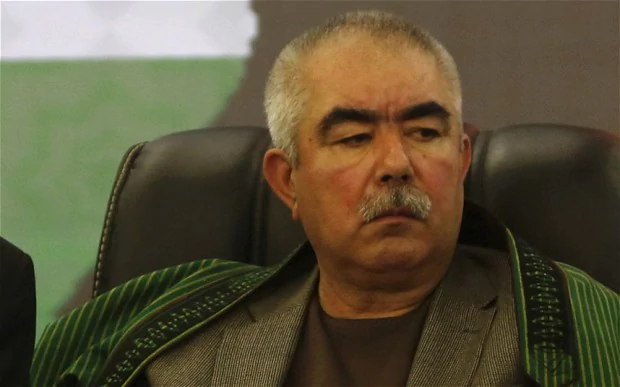 | ||
Similar People Ahmad Shah Massoud, Atta Muhammad Nur, Mohammad Najibullah, Gulbuddin Hekmatyar, Burhanuddin Rabbani Profiles | ||
Service/branch Afghan National Army | ||
Unlikely alliance in Afghan presidential poll
Abdul Rashid Dostum ( ; Dari: عبدالرشید دوستم) (born 1954) is an Afghan politician who has served as Vice President of Afghanistan since 2014. He is an ethnic Uzbek, former warlord and general, previously part of the leadership council of the National Front of Afghanistan along with Ahmad Zia Massoud and Mohammad Mohaqiq, as well as chairman of his own political party, Junbish-e Milli-yi Islami-yi Afghanistan (National Islamic Movement of Afghanistan). He also served in the past as Chairman Joint Chiefs of Staff of the Afghan National Army, a role often viewed as ceremonial.
Contents
- Unlikely alliance in Afghan presidential poll
- As u s afghanistan sign troop deal cia backed warlord behind massacre of 2 000 pows sworn in as vp
- Early life
- Careers
- Soviet war in Afghanistan
- Civil war
- Taliban and Northern Alliance era
- Operation Enduring Freedom
- Dasht i Leili massacre
- Karzai administration
- Ghani administration
- Time in Turkey
- Political and social views
- References
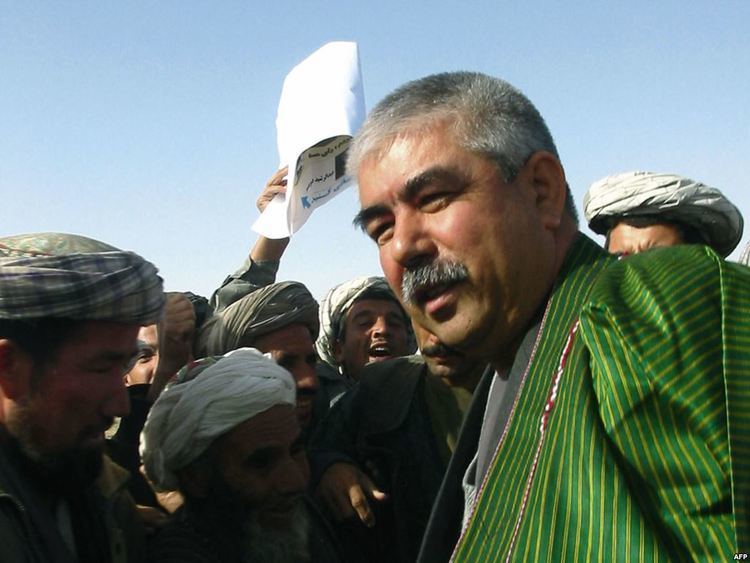
During the Soviet war in Afghanistan, Dostum was a general in the Afghan army. He later became an independent warlord and leader of Afghanistan's Uzbek community. He participated in battles against the mujahideen fighters in the 1980s as well as against the Taliban in the 1990s. After the fall of the Taliban, he mainly resided in Turkey before returning to the country. In 2013 he made a public apology for his role in the civil war. He subsequently entered parliament, and later joined Ashraf Ghani's presidential administration as a vice president.
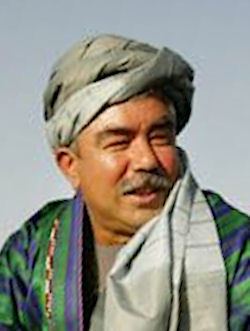
As u s afghanistan sign troop deal cia backed warlord behind massacre of 2 000 pows sworn in as vp
Early life
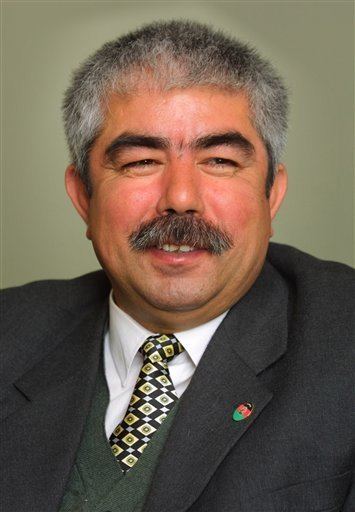
Dostum was born in 1954 in Khwaja du koh, Jowzjan Province, Afghanistan. Coming from an impoverished family, he received a very basic traditional education as he was forced to drop out of school at a young age. From there, he took up work in the gas fields.
Careers
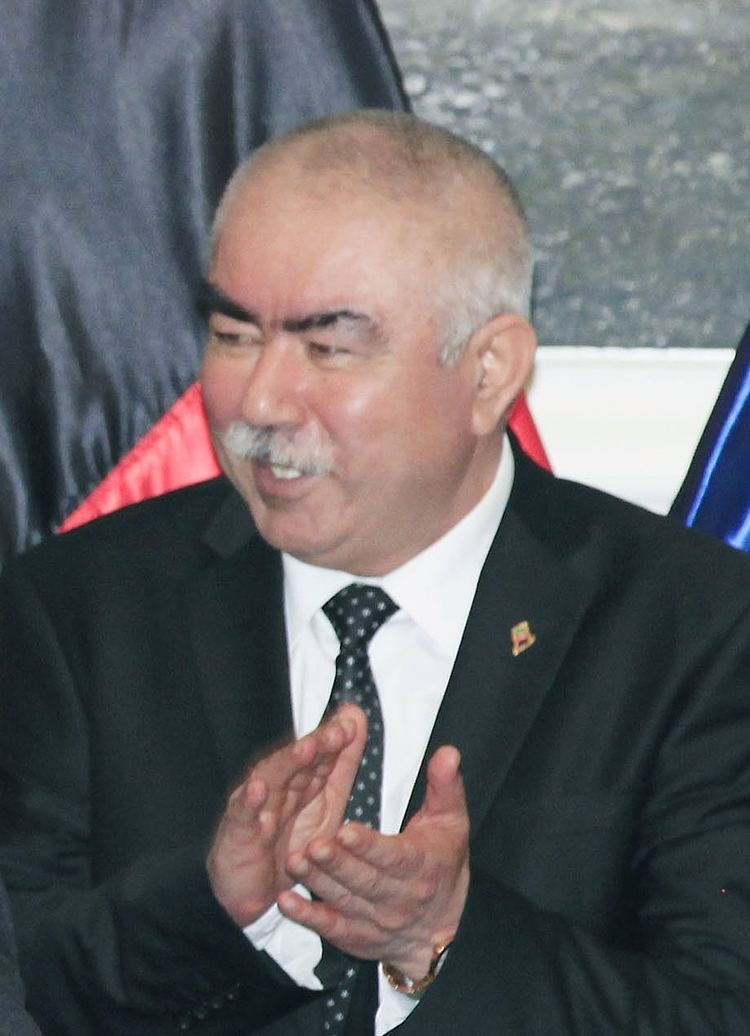
Dostum began working in 1970 in a state-owned gas refinery in Sheberghan, participating in union politics, as the new government started to arm the staff of the workers in the oil and gas refineries. The reason for this was to create "groups for the defense of the revolution". Because of the new communist ideas entering Afghanistan in the 1970s, he enlisted in the army in 1978. Dostum received his basic military training in Jalalabad. His squadron was deployed in the rural areas around Sheberghan, under the auspices of the Ministry of National Security.
Soviet war in Afghanistan
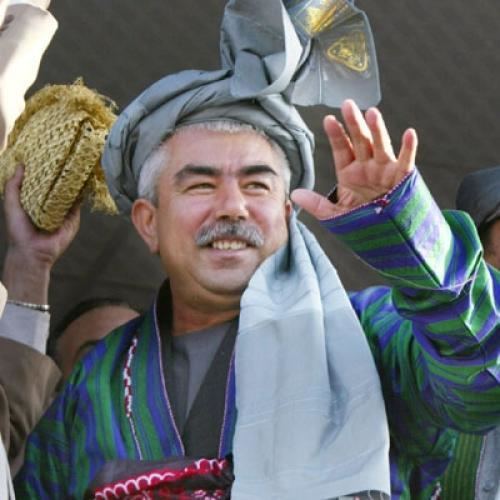
By the mid-1980s he commanded around 20,000 militia men and controlled the northern provinces of Afghanistan. While the unit recruited throughout Jowzjan and had a relatively broad base, many of its early troops and commanders came from Dostum's home village. He left the army after the purge of Parchamis, but returned after the Soviet occupation began.
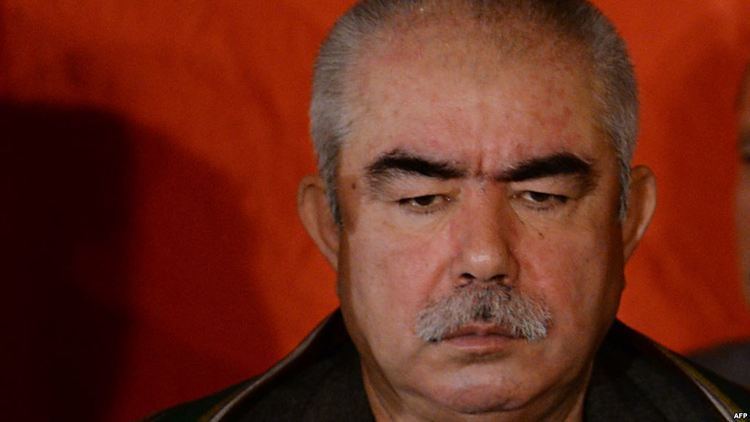
During the Soviet war in Afghanistan, Dostum was commanding a militia battalion to fight and rout mujahideen forces; he had been appointed an officer due to prior military experience. This eventually became a regiment and later became incorporated into the defense forces as the 53rd Infantry division. Dostum and his new division reported directly to President Mohammad Najibullah. Later on he became the commander of the military unit 374 in Jowzjan. He defended the Soviet-backed Afghan government against the mujahideen forces throughout the 1980s. While he was only a regional commander, he had largely raised his forces by himself. The Jowzjani militia Dostum controlled was one of the few in the country which was able to be deployed outside its own region. They were deployed in Kandahar in 1988 when Soviet forces were withdrawing from Afghanistan.
Civil war
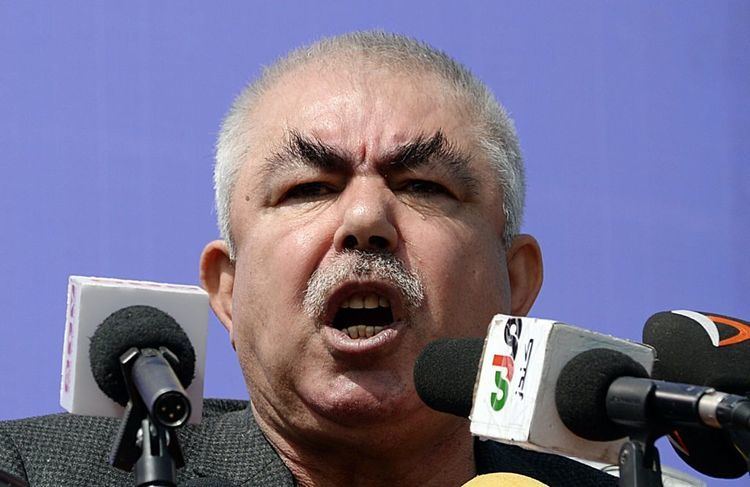
Dostum's men would become an important force in the fall of Kabul in 1992. In April 1992, the opposition forces began their march to Kabul against the government of Najibullah. Dostum had allied himself with the opposition commanders Ahmad Shah Massoud and Sayed Jafar Naderi, the head of the Isma'ili community, and together they captured the capital city. He and Massoud fought in a coalition against Gulbuddin Hekmatyar. Massoud and Dostum's forces joined together to defend Kabul against Hekmatyar, with some 4000-5000 of his troops, units of his Shiberghan-based 53rd Division and Balkh-based Guards Division, garrisoning Bala Hissar fort, Maranjan Hill, and Khwaja Rawash International Airport. In 1994, Dostum allied himself with Gulbuddin Hekmatyar against the government of Burhanuddin Rabbani and Ahmad Shah Massoud.
Taliban and Northern Alliance era
Following the rise of the Taliban and their capture of Kabul, Dostum aligned himself with the Northern Alliance (United Front) against the Taliban. He stationed his troops in the city of Mazar-e-Sharif. The Northern Alliance was assembled in late 1996 by Dostum, Massoud and Karim Khalili against the Taliban. At this point he is said to have had a force of some 50,000 men supported by both aircraft and tanks. He ruled what was, in effect, an independent region. He printed his own Afghan currency and ran a small airline named Balkh Air.
Much like other northern alliance leaders, Dostum also faced infighting within his group and was later forced to surrender his power to General Abdul Malik Pahlawan. Malik entered into secret negotiations with the Taliban, who promised to respect his authority over much of northern Afghanistan, in exchange for the apprehension of Ismail Khan, one of their enemies. Accordingly, on 25 May 1997 Malik arrested Khan, handed him over and let the Taliban enter Mazar-e-Sharif, giving them control over most of northern Afghanistan. Because of this, Dostum was forced to flee to Turkey. However, Malik soon realized that the Taliban were not sincere with their promises as he saw his men being disarmed. He then rejoined the Northern Alliance, and turned against his erstwhile allies, driving them from Mazar-e-Sharif. In October 1997, Dostum returned from exile and retook charge. After Dostum briefly regained control of Mazar-e-Sharif, the Taliban returned in 1998 and he again fled to Turkey.
Operation Enduring Freedom
Dostum returned to Afghanistan in October 2001 to join the U.S.-led campaign against the Taliban. Along with General Fahim, Ismail Khan and Mohammad Mohaqiq. In November 2001, with the beginning of the U.S. invasion of Afghanistan, and against the wishes of the CIA who distrusted Dostum, a team including Johnny Micheal Spann landed to set up communications in the Dar-e-Suf. A few hours later 23 men of Operational Detachment Alpha (ODA) 595 landed to begin the war.
On 24 November 2001, 300 Taliban soldiers retreated after the Siege of Kunduz by American and Northern Alliance. The Taliban laid down their weapons a few miles from the city of Mazar-i-Sharif. They eventually surrendered to Dostum. A small group of armed foreign fighters were transferred to the 19th century prison fortress, Qala-i-Jangi. The Taliban used concealed weapons to start the Battle of Qala-i-Jangi against the opposition forces. The uprising was eventually brought under control.
Dasht-i-Leili massacre
In late 2001, Carlotta Gall, Jamie Doran and Newsweek began reporting rumors that Dostum's forces, who were fighting the Taliban alongside the US Special Forces, intentionally suffocated as many as 2,000 Taliban prisoners in container trucks in an ill-defined incident that has become known as the Dasht-i-Leili massacre. In July 2009, The New York Times reported that according to anonymous witnesses they interviewed, "over a three-day period, Taliban prisoners were stuffed into closed metal shipping containers and given no food or water; many suffocated while being trucked to the prison. Other prisoners were killed when guards shot into the containers. The bodies were said to have been buried in a mass grave in Dasht-i-Leili, a stretch of desert just outside Sheberghan. A 2002 declassified U.S. State Department intelligence report quoting a news source states that another anonymous source concluded that about 1,500 Taliban prisoners died. Estimates from other anonymous witnesses or from a report by Physicians for Human Rights range from several hundred to several thousand. The report also says that several Afghan witnesses were later tortured or killed." Dostum, the Red Cross and eyewitnesses in the prison claimed that only 200 taliban prisoners died from wounds or sickness. Physicians for Human Rights claims there is satellite evidence that graves had been dug up but no investigation was done despite Dostum inviting the UN to investigate. No formal investigation was conducted and an official website of General Dostum using eyewitnesses who go on the record lays out a timeline of events that debunk the allegations. The foundation of the controversy lay in confusion in estimating the number of Taliban that possibly joined the Northern Alliance or simply returned to their villages after the Kunduz surrender. According to the biography "The Last Warlord, The Life and Times of General Dostum written by Professor Brian Williams, General Dostum has been the target of a number of sensational claims that were later debunked. Among them was the famous claim in Ahmed Rashid's book "The Taliban" that describes a tank was used to crush a thief. Ahmed Rashid corrects what turns out to be a second hand story in William's book and provides first person description of events that directly contradict the rumors.
Karzai administration
In the aftermath of Taliban's removal from northern Afghanistan, forces loyal to Dostum frequently clashed with Tajik forces loyal to Atta Muhammad Nur. Atta's men kidnapped and killed a number of Dostum's men, and constantly agitated to gain control of Mazar-e-Sharif. Through the political mediations of the Karzai administration, the International Security Assistance Force (ISAF) and the United Nations, the Dostum-Atta feud has gradually declined.
Dostum served as deputy defense minister the early period of the Karzai administration. In March 2003, he established a North Zone of Afghanistan. On 20 May 2003, Dostum narrowly escaped an assassination attempt. He was often residing outside Afghanistan, mainly in Turkey.
On 16 August 2009, Dostum made a requested return from exile to Afghanistan to support President Hamid Karzai in his bid for re-election. He later flew by helicopter to his northern stronghold of Sheberghan, where he was greeted by thousands of his supporters in the local stadium. He subsequently made overtures to the United States, promising he could "destroy the Taliban and al Qaeda" if supported by the U.S., saying that "the U.S. needs strong friends like Dostum."
Ghani administration
Dostum became Vice President of Afghanistan in the 2014 Afghan presidential election. His running mates were Ashraf Ghani and Sarwar Danish.
In July 2016 Human Rights Watch accused Abdul Rashid Dostum's National Islamic Movement of Afghanistan of killing, abusing and looting civilians in the northern Faryab Province during June. Militia forces loyal to Dostum stated that the civilians they targeted - at least 13 killed and 32 wounded - were supporters of the Taliban.
Time in Turkey
Some media reports stated earlier that Dostum was "seeking political asylum" in Turkey while others said he was exiled. One Turkish media outlet said Dostum was visiting after flying there with then Turkey's Foreign Minister Ali Babacan during a meeting of the Organization for Security and Cooperation in Europe (OSCE).
Political and social views
While Dostum was ruling northern Afghanistan before the Taliban took over in 1998, women were able to go about unveiled, girls were allowed to go to school and study at the University of Balkh in Mazar-e-Sharif, cinemas showed Indian films and music played on television, activities which were all banned by the Taliban.
He viewed the ISAF forces attempt to crush the Taliban as ineffective and has gone on record saying that he could mop up the Taliban "in six months" if allowed to raise a 10,000 strong army of Afghan veterans. Senior Afghan government officials do not trust Dostum as they are concerned that he might be secretly rearming his forces.
Dostum is barred from entering the U.S.
